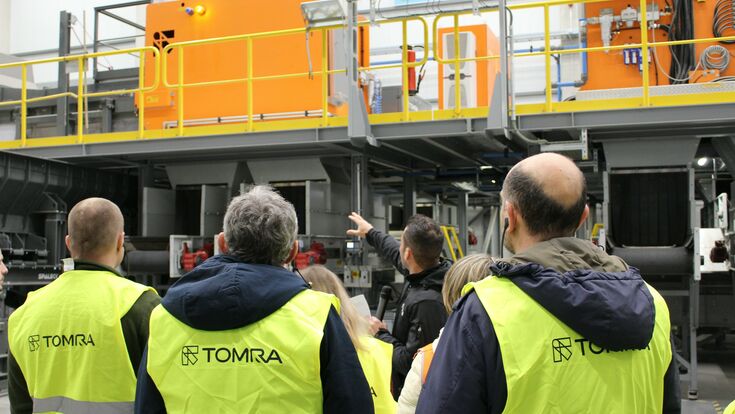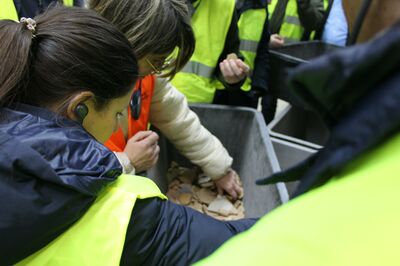Wood Recycling : Project partners from EcoReFibre visit TOMRA facilities to investigate advanced wood sorting solutions

Around 40 participants of the European research project EcoReFibre visited TOMRA’s test center to investigate the industry’s most advanced wood sorting solutions
- © EcoFibreHow can wood fibres at the end of their life cycle be efficiently recycled into new fibreboard? EcoReFibre ("Ecological solutions for recovery of secondary materials from post-consumer fibreboards"), a research project involving twenty partner organisations from seven countries, has been tackling this challenging question since its launch in May 2012, with the support of the European Union.
For its latest project meeting, some 40 participants gathered at the TOMRA site in Mülheim-Kärlich, Germany. Although TOMRA is not an official member of the EcoReFibre consortium, the company was invited by its partner DIEFFENBACHER to carry out exclusive machine demonstrations for the EcoReFibre members, reinforcing the practical application of the research results in sensor-based sorting.
Jose Matas, Director of the Wood Segment at TOMRA Recycling, said at the event: "TOMRA was the first to introduce deep learning sorting technology for waste wood recycling to the market. We are pleased that with our innovations we can not only contribute to the positive results of the EcoReFibre project but also advance the use of high-quality recycled wood fibers."
Intelligent sorting using X-ray transmission and deep learning technology
There were three different live demonstrations on two sorting systems: The first test focused on TOMRA's X-TRACT™. Thanks to its powerful X-ray transmission (XRT) technology, X-TRACT™ recovers waste wood from complex mixed streams. The sorting system detects contaminants such as inert materials, metals, plastics and glass based on atomic density and effectively separates them from the waste wood.
The experts at TOMRA carried out further tests on the AUTOSORT™ machine with the deep learning add-on GAINnext™, the technology of which is the company's latest innovation in artificial intelligence and is capable of solving very complex sorting tasks. Matas further explains, "While our X-TRACT™ effectively separates contaminants from waste wood, GAINnext™ identifies objects by their shape, size and visual characteristics, enabling it to differentiate between different types of wood or wood composites. GAINnext™ is trained by our experts using thousands of photos and will continue to evolve with further training and future updates.
During the second EcoReFibre demonstration, the intelligent sorting system recovered unprocessed wood, called Wood A, from the mixed wood fraction collected by the X-TRACT™. In the third and final step, GAINnext™ effectively sorted wood fibres from the processed wood B. The result is a clean fibreboard fraction with a purity that the EcoReFibre project participants were very pleased with.

Successful Two-Day Event
During their research trip to Germany, TOMRA was not the only company visited by the EcoReFibre consortium. On 23 April, members gathered at DIEFFENBACHER's headquarters in Eppingen to see demonstrations of the company's recycling machinery.
“In the first step, we shredded fiberboard into chip-sized pieces using our custom single-shaft shredder,” explains Jean-Christophe Zimmermann, Head of Sales of DIEFFENBACHER’s Recycling Business Unit. “These chips were then sized with the ClassiSizer to produce fines ideal for particleboard surface layers. The second part focused on fiberboard-to-fiberboard recycling, sorting waste wood into fines, chip-size, and oversize fractions with our ClassiScreen.” The chip-size material was set aside for TOMRA, while the fines were prepared for particleboard production.
All in all, the feedback from the participants over the two days was very positive. Stergios Adamopoulos, Professor of Wood Research and Technology at the Swedish University of Agricultural Sciences in Uppsala, who leads the research consortium, confirms: "We have two intensive days behind us, which have enriched the EcoReFibre project with some important findings and taken it a decisive step forward. Many thanks to TOMRA and DIEFFENBACHER. The event was highly successful. We could meet all key performance indicators, which reassures us that we're on the right track with EcoReFibre."
